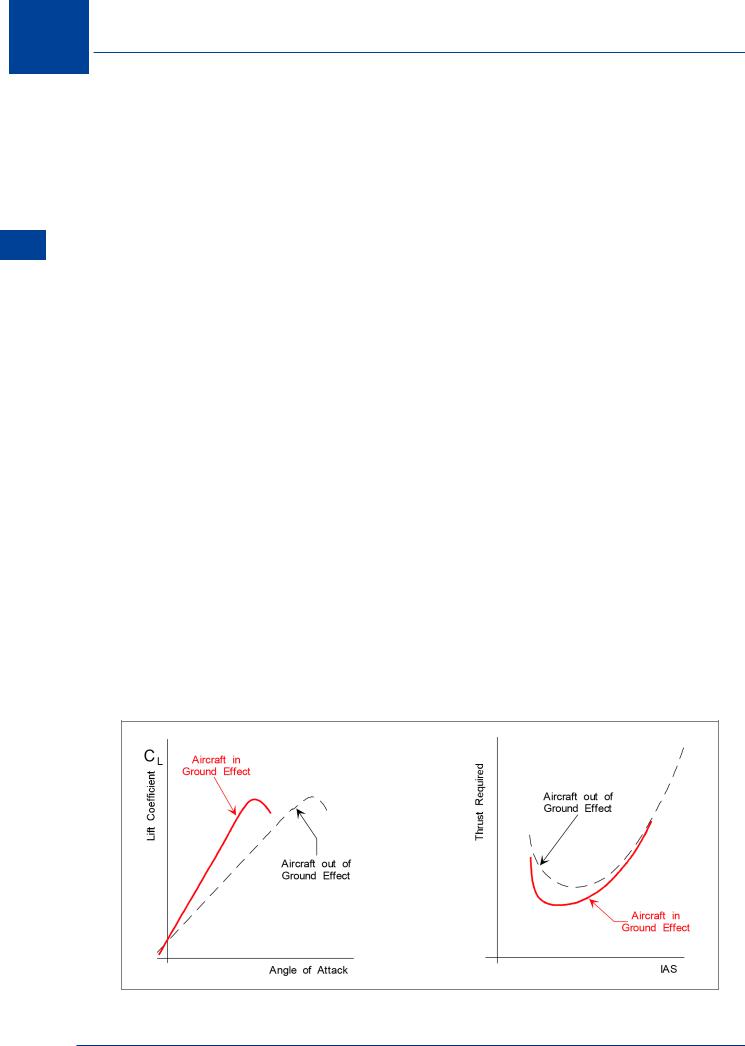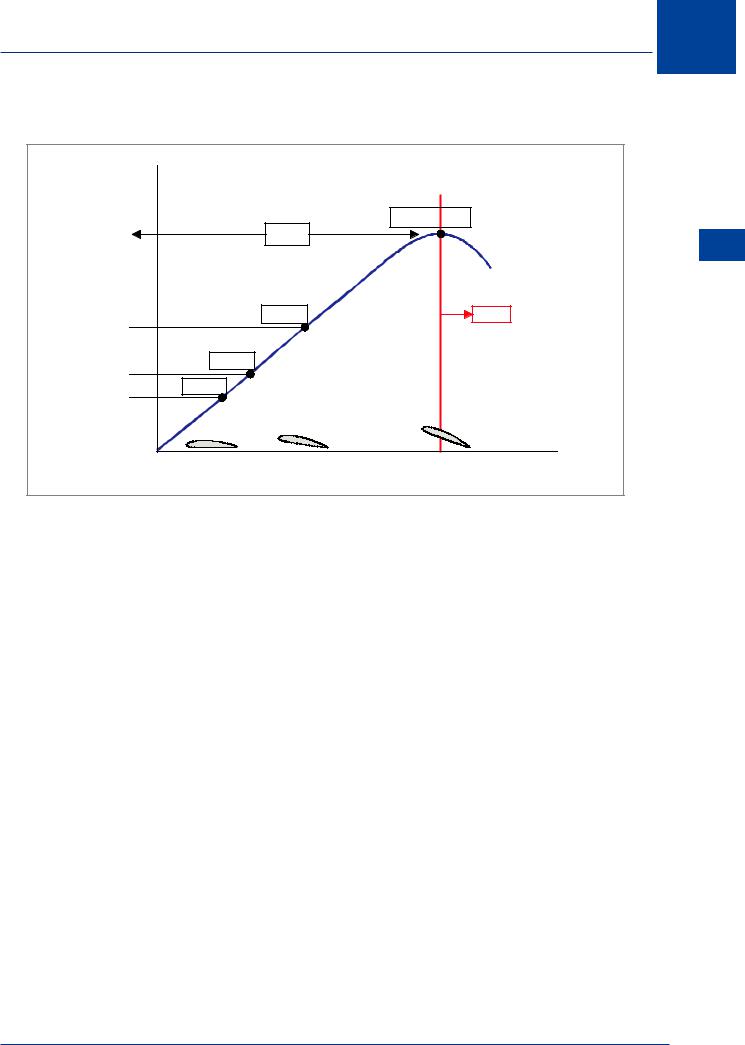
- •Textbook Series
- •Contents
- •1 Overview and Definitions
- •Overview
- •General Definitions
- •Glossary
- •List of Symbols
- •Greek Symbols
- •Others
- •Self-assessment Questions
- •Answers
- •2 The Atmosphere
- •Introduction
- •The Physical Properties of Air
- •Static Pressure
- •Temperature
- •Air Density
- •International Standard Atmosphere (ISA)
- •Dynamic Pressure
- •Key Facts
- •Measuring Dynamic Pressure
- •Relationships between Airspeeds
- •Airspeed
- •Errors and Corrections
- •V Speeds
- •Summary
- •Questions
- •Answers
- •3 Basic Aerodynamic Theory
- •The Principle of Continuity
- •Bernoulli’s Theorem
- •Streamlines and the Streamtube
- •Summary
- •Questions
- •Answers
- •4 Subsonic Airflow
- •Aerofoil Terminology
- •Basics about Airflow
- •Two Dimensional Airflow
- •Summary
- •Questions
- •Answers
- •5 Lift
- •Aerodynamic Force Coefficient
- •The Basic Lift Equation
- •Review:
- •The Lift Curve
- •Interpretation of the Lift Curve
- •Density Altitude
- •Aerofoil Section Lift Characteristics
- •Introduction to Drag Characteristics
- •Lift/Drag Ratio
- •Effect of Aircraft Weight on Minimum Flight Speed
- •Condition of the Surface
- •Flight at High Lift Conditions
- •Three Dimensional Airflow
- •Wing Terminology
- •Wing Tip Vortices
- •Wake Turbulence: (Ref: AIC P 072/2010)
- •Ground Effect
- •Conclusion
- •Summary
- •Answers from page 77
- •Answers from page 78
- •Questions
- •Answers
- •6 Drag
- •Introduction
- •Parasite Drag
- •Induced Drag
- •Methods of Reducing Induced Drag
- •Effect of Lift on Parasite Drag
- •Aeroplane Total Drag
- •The Effect of Aircraft Gross Weight on Total Drag
- •The Effect of Altitude on Total Drag
- •The Effect of Configuration on Total Drag
- •Speed Stability
- •Power Required (Introduction)
- •Summary
- •Questions
- •Annex C
- •Answers
- •7 Stalling
- •Introduction
- •Cause of the Stall
- •The Lift Curve
- •Stall Recovery
- •Aircraft Behaviour Close to the Stall
- •Use of Flight Controls Close to the Stall
- •Stall Recognition
- •Stall Speed
- •Stall Warning
- •Artificial Stall Warning Devices
- •Basic Stall Requirements (EASA and FAR)
- •Wing Design Characteristics
- •The Effect of Aerofoil Section
- •The Effect of Wing Planform
- •Key Facts 1
- •Super Stall (Deep Stall)
- •Factors that Affect Stall Speed
- •1g Stall Speed
- •Effect of Weight Change on Stall Speed
- •Composition and Resolution of Forces
- •Using Trigonometry to Resolve Forces
- •Lift Increase in a Level Turn
- •Effect of Load Factor on Stall Speed
- •Effect of High Lift Devices on Stall Speed
- •Effect of CG Position on Stall Speed
- •Effect of Landing Gear on the Stall Speed
- •Effect of Engine Power on Stall Speed
- •Effect of Mach Number (Compressibility) on Stall Speed
- •Effect of Wing Contamination on Stall Speed
- •Warning to the Pilot of Icing-induced Stalls
- •Stabilizer Stall Due to Ice
- •Effect of Heavy Rain on Stall Speed
- •Stall and Recovery Characteristics of Canards
- •Spinning
- •Primary Causes of a Spin
- •Phases of a Spin
- •The Effect of Mass and Balance on Spins
- •Spin Recovery
- •Special Phenomena of Stall
- •High Speed Buffet (Shock Stall)
- •Answers to Questions on Page 173
- •Key Facts 2
- •Questions
- •Key Facts 1 (Completed)
- •Key Facts 2 (Completed)
- •Answers
- •8 High Lift Devices
- •Purpose of High Lift Devices
- •Take-off and Landing Speeds
- •Augmentation
- •Flaps
- •Trailing Edge Flaps
- •Plain Flap
- •Split Flap
- •Slotted and Multiple Slotted Flaps
- •The Fowler Flap
- •Comparison of Trailing Edge Flaps
- •and Stalling Angle
- •Drag
- •Lift / Drag Ratio
- •Pitching Moment
- •Centre of Pressure Movement
- •Change of Downwash
- •Overall Pitch Change
- •Aircraft Attitude with Flaps Lowered
- •Leading Edge High Lift Devices
- •Leading Edge Flaps
- •Effect of Leading Edge Flaps on Lift
- •Leading Edge Slots
- •Leading Edge Slat
- •Automatic Slots
- •Disadvantages of the Slot
- •Drag and Pitching Moment of Leading Edge Devices
- •Trailing Edge Plus Leading Edge Devices
- •Sequence of Operation
- •Asymmetry of High Lift Devices
- •Flap Load Relief System
- •Choice of Flap Setting for Take-off, Climb and Landing
- •Management of High Lift Devices
- •Flap Extension Prior to Landing
- •Questions
- •Annexes
- •Answers
- •9 Airframe Contamination
- •Introduction
- •Types of Contamination
- •Effect of Frost and Ice on the Aircraft
- •Effect on Instruments
- •Effect on Controls
- •Water Contamination
- •Airframe Aging
- •Questions
- •Answers
- •10 Stability and Control
- •Introduction
- •Static Stability
- •Aeroplane Reference Axes
- •Static Longitudinal Stability
- •Neutral Point
- •Static Margin
- •Trim and Controllability
- •Key Facts 1
- •Graphic Presentation of Static Longitudinal Stability
- •Contribution of the Component Surfaces
- •Power-off Stability
- •Effect of CG Position
- •Power Effects
- •High Lift Devices
- •Control Force Stability
- •Manoeuvre Stability
- •Stick Force Per ‘g’
- •Tailoring Control Forces
- •Longitudinal Control
- •Manoeuvring Control Requirement
- •Take-off Control Requirement
- •Landing Control Requirement
- •Dynamic Stability
- •Longitudinal Dynamic Stability
- •Long Period Oscillation (Phugoid)
- •Short Period Oscillation
- •Directional Stability and Control
- •Sideslip Angle
- •Static Directional Stability
- •Contribution of the Aeroplane Components.
- •Lateral Stability and Control
- •Static Lateral Stability
- •Contribution of the Aeroplane Components
- •Lateral Dynamic Effects
- •Spiral Divergence
- •Dutch Roll
- •Pilot Induced Oscillation (PIO)
- •High Mach Numbers
- •Mach Trim
- •Key Facts 2
- •Summary
- •Questions
- •Key Facts 1 (Completed)
- •Key Facts 2 (Completed)
- •Answers
- •11 Controls
- •Introduction
- •Hinge Moments
- •Control Balancing
- •Mass Balance
- •Longitudinal Control
- •Lateral Control
- •Speed Brakes
- •Directional Control
- •Secondary Effects of Controls
- •Trimming
- •Questions
- •Answers
- •12 Flight Mechanics
- •Introduction
- •Straight Horizontal Steady Flight
- •Tailplane and Elevator
- •Balance of Forces
- •Straight Steady Climb
- •Climb Angle
- •Effect of Weight, Altitude and Temperature.
- •Power-on Descent
- •Emergency Descent
- •Glide
- •Rate of Descent in the Glide
- •Turning
- •Flight with Asymmetric Thrust
- •Summary of Minimum Control Speeds
- •Questions
- •Answers
- •13 High Speed Flight
- •Introduction
- •Speed of Sound
- •Mach Number
- •Effect on Mach Number of Climbing at a Constant IAS
- •Variation of TAS with Altitude at a Constant Mach Number
- •Influence of Temperature on Mach Number at a Constant Flight Level and IAS
- •Subdivisions of Aerodynamic Flow
- •Propagation of Pressure Waves
- •Normal Shock Waves
- •Critical Mach Number
- •Pressure Distribution at Transonic Mach Numbers
- •Properties of a Normal Shock Wave
- •Oblique Shock Waves
- •Effects of Shock Wave Formation
- •Buffet
- •Factors Which Affect the Buffet Boundaries
- •The Buffet Margin
- •Use of the Buffet Onset Chart
- •Delaying or Reducing the Effects of Compressibility
- •Aerodynamic Heating
- •Mach Angle
- •Mach Cone
- •Area (Zone) of Influence
- •Bow Wave
- •Expansion Waves
- •Sonic Bang
- •Methods of Improving Control at Transonic Speeds
- •Questions
- •Answers
- •14 Limitations
- •Operating Limit Speeds
- •Loads and Safety Factors
- •Loads on the Structure
- •Load Factor
- •Boundary
- •Design Manoeuvring Speed, V
- •Effect of Altitude on V
- •Effect of Aircraft Weight on V
- •Design Cruising Speed V
- •Design Dive Speed V
- •Negative Load Factors
- •The Negative Stall
- •Manoeuvre Boundaries
- •Operational Speed Limits
- •Gust Loads
- •Effect of a Vertical Gust on the Load Factor
- •Effect of the Gust on Stalling
- •Operational Rough-air Speed (V
- •Landing Gear Speed Limitations
- •Flap Speed Limit
- •Aeroelasticity (Aeroelastic Coupling)
- •Flutter
- •Control Surface Flutter
- •Aileron Reversal
- •Questions
- •Answers
- •15 Windshear
- •Introduction (Ref: AIC 84/2008)
- •Microburst
- •Windshear Encounter during Approach
- •Effects of Windshear
- •“Typical” Recovery from Windshear
- •Windshear Reporting
- •Visual Clues
- •Conclusions
- •Questions
- •Answers
- •16 Propellers
- •Introduction
- •Definitions
- •Aerodynamic Forces on the Propeller
- •Thrust
- •Centrifugal Twisting Moment (CTM)
- •Propeller Efficiency
- •Variable Pitch Propellers
- •Power Absorption
- •Moments and Forces Generated by a Propeller
- •Effect of Atmospheric Conditions
- •Questions
- •Answers
- •17 Revision Questions
- •Questions
- •Answers
- •Explanations to Specimen Questions
- •Specimen Examination Paper
- •Answers to Specimen Exam Paper
- •Explanations to Specimen Exam Paper
- •18 Index

Lift 5
5 Lift
Conclusion
Increasing downwash (G to D) gives a decrease in tailplane (effective) angle of attack and decreasing downwash (D to G) gives an increase in tailplane (effective) angle of attack.
It is necessary to understand the effect of changing downwash on tailplane angle of attack, but it is vital to understand the influence of downwash on aircraft pitching moment.
Entering Ground Effect
Consider an aircraft entering ground effect, assuming that a constant CL and IAS is maintained. As the aircraft descends into ground effect the following changes will take place:
•The decreased downwash will give an increase in the effective angle of attack, requiring a smaller wing angle of attack to produce the same lift coefficient. If a constant pitch attitude is maintained as ground effect is encountered, a “floating” sensation may be experienced due to the increase in CL and the decrease in CDi (thrust requirement),
•Figure 5.15 & Figure 5.26. The decrease of induced drag will cause a reduction in deceleration, and any excess speed may lead to a considerable “float” distance. The reduction in thrust required might also give the aircraft a tendency to climb above the desired glide path, “balloon”, if a reduced throttle setting is not used.
•If airspeed is allowed to decay significantly during short finals and the resulting sink-rate arrested by increasing the angle of attack, upon entering ground effect the wing could stall, resulting in a heavy landing.
•The pilot may need to increase pitch input (more elevator back-pressure) to maintain the desired landing attitude. This is due to the decreased downwash increasing the effective angle of attack of the tailplane, Figure 5.23. The down load on the tail is reduced, producing a nose-down pitching moment.
•Due to the changes in the flowfield around the aircraft there will be a change in position error which may cause the ASI to misread. In the majority of cases, local pressure at the static port will increase and cause the ASI and altimeter to under-read.
Figure 5.26
96

Lift 5
Leaving Ground Effect
The effects of climbing out of ground effect will generally be the opposite to those of entering. Consider an aircraft climbing out of ground effect while maintaining a constant CL and IAS. As the aircraft climbs out of ground effect the following changes will take place:
•The CL will reduce and the CDi (thrust requirement) will increase. The aircraft will require an increase in angle of attack to maintain the same CL.
•The increase in downwash will generally produce a nose-up pitching moment. The pitch input from the pilot may need to be reduced (less elevator back-pressure).
•Position error changes may cause the ASI to misread. In the majority of cases, local pressure at the static port will decrease and cause the ASI and altimeter to over-read.
•It is possible to become airborne in ground effect at an airspeed and angle of attack which would, after leaving ground effect, cause the aircraft to settle back on to the runway It is therefore vitally important that correct speeds are used for take-off.
•The nose-up pitching moment may induce an inadvertent over rotation and tail strike.
Lift 5
97

5 Lift
Summary
Three major factors influence production of the required lift force:
•Dynamic Pressure (IAS).
•Pressure Distribution (section profile & angle of attack).
•Wing Area (S).
5 To provide a constant lift force, each IAS corresponds to a particular angle of attack.
Lift
The angle of attack at CLMAX is constant.
A higher aircraft weight requires an increase in lift force to balance it; an increased IAS is needed to provide the greater lift at the same angle of attack.
As altitude increases, a constant IAS will supply the same lift force at a given angle of attack.
A thinner wing will generate less lift at a given angle of attack, and have a higher minimum speed.
A thinner wing can fly faster before shock wave formation increases drag.
A thinner wing requires high lift devices to have an acceptably low minimum speed.
The Lift/Drag ratio is a measure of aerodynamic efficiency.
Contamination of the wing surface, particularly the front 20% of the chord, will seriously decrease aerodynamic performance.
Wing tip vortices:
•Decrease overall lift production.
•Increase drag.
•Modify the downwash which changes the effective angle of attack of the tailplane.
•Generate trailing vortices which pose a serious hazard to aircraft that encounter them.
•Affect the stall characteristics of the wing.
•Change the lift distribution.
The sudden full effects of vortices or their absence must be anticipated during take-off and landing.
98

|
|
|
Lift |
5 |
Answers from page 77 |
|
|
|
|
|
CL |
|
|
|
1.532 |
|
CLMAX |
150 Knots |
|
|
|
5 |
||
|
|
|
|
|
|
|
|
|
Lift |
0.863 |
|
200 kt |
STALL |
|
|
|
|
|
|
0.552 |
250 kt |
|
|
|
300 kt |
|
|
|
|
0.384 |
|
|
|
|
|
|
|
|
|
|
|
|
ANGLE OF ATTACK ( DEGREES ) |
|
Figure 5.27
a.How many newtons of lift are required for straight and level flight? 588 600 N.
b.Calculate the airspeed in knots for each highlighted coefficient of lift. As above.
c.What is the lowest speed at which the aircraft can be flown in level flight? 150 kt.
d.What coefficient of lift must be used to fly as slowly as possible in level flight? CLMAX
e.Does each angle of attack require a particular speed? Yes.
f.As speed is increased, what must be done to the angle of attack to maintain level flight?
Angle of attack must be decreased.
g.At higher altitude air density will be lower; what must be done to maintain the required lift force?
Increase the True Airspeed (TAS).
h.At a constant altitude, if speed is halved, what must be done to the angle of attack to maintain level flight?
Increased so that CL is four times greater.
99
